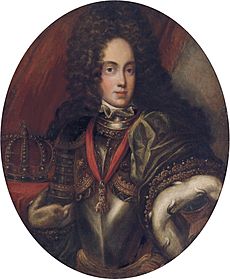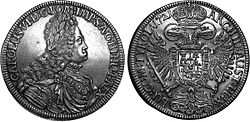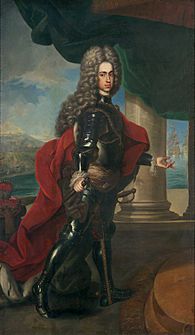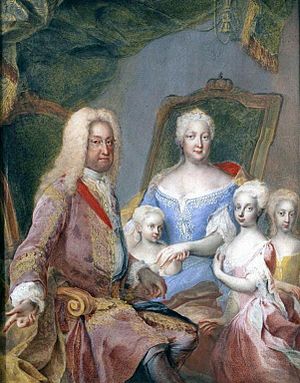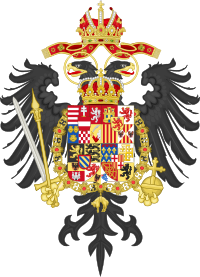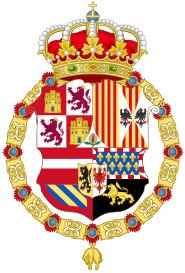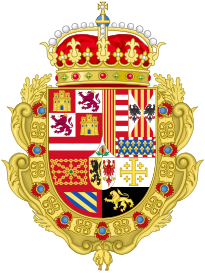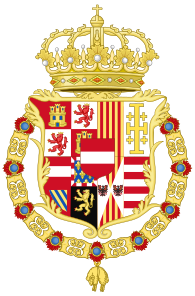Charles VI, Holy Roman Emperor facts for kids
Quick facts for kids Charles VI |
|||||
|---|---|---|---|---|---|
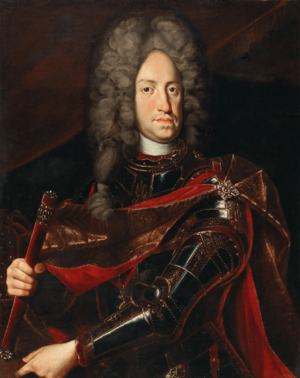
Portrait by Jacob van Schuppen
|
|||||
| Holy Roman Emperor (more...) | |||||
| Reign | 12 October 1711 – 20 October 1740 | ||||
| Proclamation | 22 December 1711, Frankfurt | ||||
| Predecessor | Joseph I | ||||
| Successor | Charles VII | ||||
| Governors |
See list
|
||||
| Born | 1 October 1685 Hofburg Palace, Vienna |
||||
| Died | 20 October 1740 (aged 55) Palais Augarten, Vienna |
||||
| Burial | Imperial Crypt | ||||
| Spouse | |||||
| Issue Detail |
|
||||
|
|||||
| House | Habsburg | ||||
| Father | Leopold I, Holy Roman Emperor | ||||
| Mother | Eleonore Magdalene of Neuburg | ||||
| Religion | Roman Catholicism | ||||
| Signature |  |
||||
Charles VI (born October 1, 1685 – died October 20, 1740) was a powerful ruler. He was the Holy Roman Emperor and led the Habsburg monarchy from 1711 until his death. He took over after his older brother, Joseph I, passed away.
Charles also tried to become King of Spain, but he wasn't successful. In 1708, he married Elisabeth Christine of Brunswick-Wolfenbüttel. They had four children together. Sadly, two of them, Leopold Johann and Maria Amalia, died when they were very young. His other two daughters were Maria Theresa and Maria Anna.
Before Maria Theresa was born, Charles faced a problem. He didn't have any sons to inherit his lands. So, he created a special rule called the Pragmatic Sanction of 1713. This rule said that his daughters could inherit his lands, even though old laws usually only allowed sons. He wanted other European countries to agree to this rule. Many countries did, but some later changed their minds. When Charles died in 1740, this led to a big war called the War of the Austrian Succession. This war was a challenge for his daughter, Maria Theresa.
Contents
Biography of Charles VI
Early Life and Claim to Spain
Charles was born on October 1, 1685. He was the second son of Emperor Leopold I.
In 1700, the King of Spain, Charles II of Spain, died without any children. Charles VI, who was also a member of the House of Habsburg, said he should be the new King of Spain. This started a long war called the War of the Spanish Succession. It lasted for almost 14 years. France supported a different person, Philip, to be King of Spain.
Many countries, including England and most of the Holy Roman Empire, supported Charles. Charles went to Spain in 1705 and stayed there for six years. He was only able to control a small part of Spain. When his brother, Joseph I, died, Charles had to return to Vienna to become the Holy Roman Emperor.
The new Kingdom of Great Britain then stopped supporting Charles. They didn't want Austria and Spain to be ruled by the same person. The war ended with the Treaties of Utrecht and Rastatt. These treaties said that Philip would be King of Spain. However, Austria gained control of lands like Naples, Milan, and the Austrian Netherlands. Charles was very unhappy about losing Spain.
Charles's family arranged for him to marry Elisabeth Christine of Brunswick-Wolfenbüttel. She was known for her beauty.
Becoming Emperor and the Pragmatic Sanction
When Charles became emperor in 1711, he was the last male heir in his family line. Old laws meant that women could not inherit his lands. Because he didn't have a son, his lands would have been divided after his death.
To prevent this, Charles created the Pragmatic Sanction of 1713 on April 19, 1713. This rule changed the law so that his lands would stay together. It also allowed his daughters to inherit everything.
Charles had three daughters who lived past infancy: Maria Theresa (born 1717), Maria Anna (born 1718), and Maria Amalia (born 1724). He had no sons who survived. When Maria Theresa was born, Charles decided that she and his other daughters would inherit his lands. This was instead of his older brother Joseph's daughters. This decision made it harder for a smooth transfer of power. Charles spent the rest of his rule trying to get other European countries to agree to his Pragmatic Sanction.
Charles agreed to close a trading company called the Ostend Company. This company was based in the Austrian Netherlands. Britain had asked him to close it.
Many countries, including Britain, France, and Spain, signed the Pragmatic Sanction. However, some countries later went back on their word. For example, France secretly agreed to support another ruler's claim to Charles's lands.
In the early part of his rule, Charles's empire grew. He won a war against the Ottoman Empire (the Austro-Turkish War (1716–1718)). This added new areas like Banat and Serbia to his control. This expanded Austrian rule along the Danube River.
Another war, the War of the Quadruple Alliance (1718–1720), also ended in an Austrian victory. Charles traded the island of Sardinia for Sicily. Sicily was a larger island in the Mediterranean Sea. The treaty also recognized a Spanish prince, Don Carlos, as the future ruler of Parma and Tuscany.
Peace in Europe was broken by the War of the Polish Succession (1733–1738). This was a fight over who would be the next King of Poland. Austria supported one candidate, while France supported another. The war ended with a treaty. Charles had to give the Kingdom of Naples to Don Carlos. In return, he received the smaller Duchy of Parma.
Charles also had to arrange a marriage for his oldest daughter, Maria Theresa. She was first engaged to Léopold Clément, but he died. His younger brother, Francis Stephen, then came to Vienna. Charles eventually agreed to their marriage. During the War of the Polish Succession, France demanded that Francis give up his home region, Duchy of Lorraine. Charles made Francis agree to this.
In 1737, Charles started another war against the Ottoman Empire with Russia as an ally. This war did not go well for Austria. Much of the land gained earlier was lost. People in Vienna were unhappy about the costly war.
Death and Legacy
When Charles died, the Habsburg lands were in debt. The army was small and spread out. People thought that Hungary might try to break away from Habsburg rule.
Charles became very ill after a hunting trip. He died on October 20, 1740, in Vienna. His life's main goal, the Pragmatic Sanction, did not prevent war. Weeks after his death, Maria Theresa had to fight to keep her inheritance. This was the War of the Austrian Succession. She managed to keep her crown and most of her lands. However, she lost the rich region of Duchy of Silesia to Prussia and the Duchy of Parma to Spain.
Emperor Charles VI has been featured on many collector's coins and medals. For example, his portrait is on the Austrian Göttweig Abbey commemorative coin from 2006.
Children
| Name | Portrait | Lifespan | Notes |
|---|---|---|---|
| Leopold Johann | 13 April 1716 – 4 November 1716 |
Archduke of Austria, died when he was seven months old. | |
| Maria Theresa | 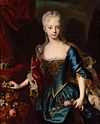 |
13 May 1717 – 29 November 1780 |
Archduchess of Austria and the main heir of the Habsburg family. She married Francis III Stephen, Duke of Lorraine. She became a very important ruler. |
| Maria Anna |  |
14 September 1718 – 16 December 1744 |
Archduchess of Austria. She married Prince Charles Alexander of Lorraine. She helped rule the Austrian Netherlands. |
| Maria Amalia |  |
5 April 1724 – 19 April 1730 |
Archduchess of Austria, died when she was six years old. |
Heraldry
| Heraldry of Charles VI, Holy Roman Emperor | ||||||||
|---|---|---|---|---|---|---|---|---|
|
Images for kids
See also
 In Spanish: Carlos VI del Sacro Imperio Romano Germánico para niños
In Spanish: Carlos VI del Sacro Imperio Romano Germánico para niños


